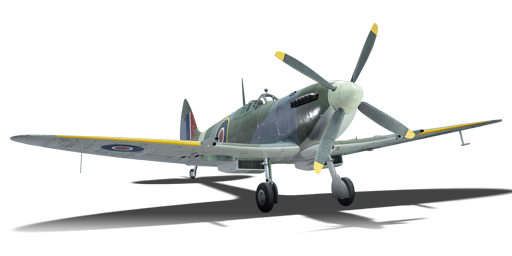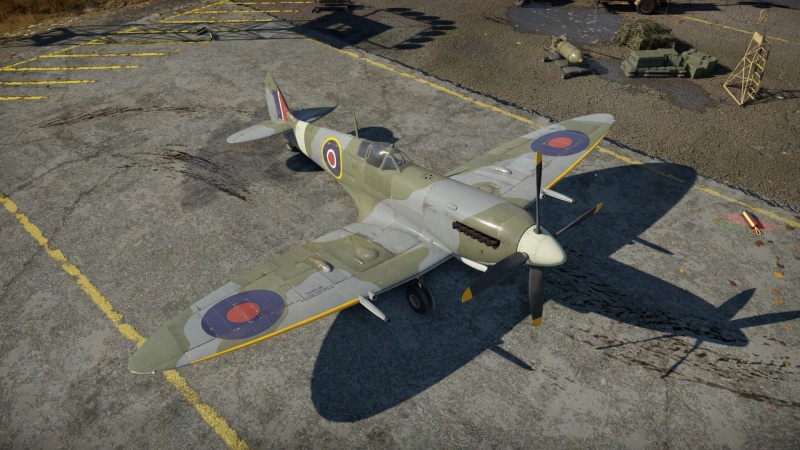Spitfire LF Mk IX
| This page is about the British fighter Spitfire LF Mk IX. For other versions, see Spitfire (Family). |
Contents
Description
By March 1943, a new version of the Merlin engine had been developed. Designated the Merlin 66, it was even more powerful than the preceding 61 and 63 versions, was tuned for low-altitude operation, and featured a new injection-based carburettor instead of the float carburettor of previous models, completely resolving the fuel-flow issues during zero-G manoeuvres and inverted flight. Spitfire F Mk IXs equipped with this new engine were designated LF (low-altitude fighter) Mk IX (also commonly referred to as the Spitfire Mk IXb). Production of the improved type completely replaced those equipped with older engines by late 1943, and the LF became the most produced variant of the Mk IX, with over 4,000 aircraft built.
Introduced in Update 1.35, the Spitfire LF Mk IX is very much a short range, point interceptor fighter and the stand-out fighter in the mid Spitfire line-up. It features an exceptional rate of climb, whilst still retaining the manoeuvrability of its early lineage. The LF Mk IX is considered by many to be the perfect Spitfire due to its balanced all-round performance and impressive statistics. The last of the Merlin-engined Spitfires before progressing on to the Griffon-powered variants, it has the perfect balance of turning performance (second only to its Japanese counterparts) as well as its "Boom and Zoom" capability that becomes more possible with later model Spitfires. However, the LF Mk IX also reverts to the rather outmoded twin cannon and twin machine gun layout of its predecessors, which can result in rather meagre damage output compared to its contemporaries and opponents.
General info
Flight performance
| Characteristics | Max Speed (km/h at 4,878 m) |
Max altitude (metres) |
Turn time (seconds) |
Rate of climb (metres/second) |
Take-off run (metres) | |||
|---|---|---|---|---|---|---|---|---|
| AB | RB | AB | RB | AB | RB | |||
| Stock | 632 | 612 | 11500 | 16.4 | 17.0 | 22.2 | 22.2 | 320 |
| Upgraded | 731 | 690 | 14.8 | 14.8 | 43.3 | 31.8 | ||
Details
| Features | ||||
|---|---|---|---|---|
| Combat flaps | Take-off flaps | Landing flaps | Air brakes | Arrestor gear |
| X | X | ✓ | X | X |
| Limits | ||||||
|---|---|---|---|---|---|---|
| Wings (km/h) | Gear (km/h) | Flaps (km/h) | Max Static G | |||
| Combat | Take-off | Landing | + | - | ||
| 774 | 270 | N/A | N/A | 230 | ~10 | ~4 |
| Optimal velocities (km/h) | |||
|---|---|---|---|
| Ailerons | Rudder | Elevators | Radiator |
| < 321 | < 400 | < 350 | > 470 |
| Compressor | Optimal altitude | 100% Engine power | WEP Engine power |
|---|---|---|---|
| Setting 1 | 3,600 m | 1,440 hp | 1,843 hp |
| Setting 2 | 6,800 m | 1,340 hp | 1,664 hp |
Survivability and armour
- 38 mm Bulletproof glass in the cockpit front.
- 4 mm Steel plate in the pilot's seat.
- 6-7 mm Steel plates behind the pilot.
- 3 mm Steel plate on top of the fuel tanks.
- 3 mm Steel boxes around the wing ammunition.
Modifications and economy
Armaments
Offensive armament
The Spitfire LF Mk IX is armed with:
- 2 x 20 mm Hispano Mk.II cannons, wing-mounted (135 rpg = 270 total)
- 2 x 12.7 mm M2 Browning machine guns, wing-mounted (260 rpg = 520 total)
Suspended armament
The Spitfire LF Mk IX can be outfitted with the following ordnance:
- Without load
- 1 x 250 lb AN-M57 bomb (250 lb total)
Usage in battles
The Spitfire LF Mk IX is a fighter aircraft that excels in dogfighting thanks to its high manoeuvrability. It is able to outturn nearly every other plane that it might face, except for a few Japanese fighters. However, engaging in extended turnfights usually should not be the pilot's first course of action when facing an opponent. Instead, the pilot should use the Spitfire's incredible rate of climb to gain an altitude advantage over the enemy. Then, it's easy to boom and zoom over lower-energy targets. This strategy works well thanks to the plane's good energy retention, although its lacklustre guns sometimes makes high-speed shooting unreliable.
If an altitude advantage is not possible, then the aircraft's manoeuvrability can shine. If the enemy can be lured into a turnfight, then there is almost no chance that they can come out on top. In rolling scissors manoeuvres, the Spitfire is also quite capable, but its roll rate may be lacking against some opponents.
At high speeds, the Spitfire tends to compress, losing control authority in both the roll and pitch axes. This can make it surprisingly difficult to recover from steep dives, and given the Spitfire's relatively low red-line speed, it is often necessary to spiral downwards instead of diving straight down if the pilot wishes to lose altitude quickly.
Due to this plane's vulnerabilities, namely a low ammunition load and somewhat flimsy airframe, it is not recommended to attack bombers with heavy defensive armament. In fact, the Hispano cannons' sometimes unreliable damage output means that it can be wise to choose attacking smaller, lighter targets (single-engine fighters) over larger ones (heavy fighters and attackers). All else being equal, and as long as teammates or win conditions are not being immediately threatened, attacking a single-engine fighter instead of a larger plane will usually yield greater results and a quicker victory.
In Ground Realistic battles, the Spitfire is ill-equipped to attack ground targets. Its 20 mm cannons don't have the ammo count or penetration to do reliable damage to armoured targets, and its single 250 lb bomb does little against tanks unless aimed near-perfectly. However, it is still an excellent air superiority fighter. In the dogfight-centric playstyle of aircraft in Ground Realistic battles, the Spitfire's amazing turn rate makes it shine.
Manual Engine Control
| MEC elements | ||||||
|---|---|---|---|---|---|---|
| Mixer | Pitch | Radiator | Supercharger | Turbocharger | ||
| Oil | Water | Type | ||||
| Controllable | Controllable Auto control available |
Not controllable Not auto controlled |
Controllable Auto control available |
Combined | Controllable 2 gears |
Not controllable |
As with all the other British planes, this plane is also very forgiving when using Manual Engine Settings.
Prop pitch: This should be set to 100% when climbing to utilize the aircraft's superior climb rate. This will come in handy both at the start of a match and during combat. However when in level flight or chasing another plane this can be set back as far to 70-80% to get a few more km/h.
Radiator: The radiator can be set to around 30% when using 100% power, however setting the radiator to around 80% will allow you to use WEP for the entire game.
Supercharger: Switching this at 2,000 m (6,561 ft) will give you quite a boost in performance and it will retain its climbrate up until 4,500 m, after it will suffer miserably but still climb better than almost every plane. Therefore the supercharger gears should be switched at 2 km (6,561 ft) altitude
Pros and cons
Pros:
- Supreme rate of climb that will rival that of the later Griffon Spitfires and most late war props (46.7 m/s in AB, 31.8 m/s in RB/SB when maxed out, beating the F8F-1B at altitudes below 7 km)
- Excellent low speed acceleration and climb
- Exceptional manoeuvrability at all altitudes
- Decent energy retention
- M2 Browning .50 cal machine guns are more powerful than the old .303 Brownings
- Has access to 150 Octane Fuel will increase your engine power by a large margin
Cons:
- Sub average roll rate can make the plane suffer in tight scissors
- Limited dive rate, moderate parasitic drag
- Limited ammo capacity
- Even slight damage to the wings can greatly impact performance negatively
- Poor top speed due to high parasitic drag compared to engine power
- Since it is an LF (low-altitude fighter) Spitfire, this Spitfire's performance suffers at high altitude
- Poor ground attack capability
History
| Archive of the in-game description | |
|---|---|
|
The Supermarine Spitfire was a British single-engine, all-metal, low-wing monoplane fighter. While the Mk VII and Mk VIII variants was being designed, a Spitfire Mk III was tested in September 1941 with the new Rolls Royce 60 in the hopes of developing an interim fighter to use as a stop gap measure. The new Spitfire performed exceptionally well, and was rushed into production as the Mk IX. The Air Fighting Development Unit described the Mk IX as 'outstandingly better than the Mk V especially at heights above 20,000 feet' and even though it was not fitted with the modified control surfaces under development for the Mk VII and Mk VIII, the Mk IX was more than capable of meeting the Focke-Wulf FW190 on favourable terms. The Mk IX was fitted with the Type C 'universal' wing and originally carried the tried and tested combination of two 20mm cannon and four 0.303 inch machine guns, but in later versions the four 0.303 machine guns were replaced with two .50 calibre guns. A total of 5,665 Mk IX were produced and 262 more Mk Vs were converted to Mk IX. Intended as a transitional stop-gap measure for the Mk VII and Mk VIII, the variant remained in production until the end of the war, ultimately becoming the most mass-produced Spitfire version. This mark was also used as a fighter-bomber and as a reconnaissance aircraft. Further modifications were incorporated into the Mk IX throughout its service life, such as a gyroscopic gunsight, bubble canopy and modified engine intercooler. Widely considered to be the most capable fighter in the world at the time of its introduction, it would take the introduction of the Rolls Royce Griffon engine to push the Spitfire into its next stage of evolution. | |
Media
- Skins
- Videos
See also
- Other late Merlin-engine LF variant Spitfires
External links
| Supermarine | |
|---|---|
| Spitfires | |
| Merlin engine | Spitfire Mk Ia · Spitfire Mk IIa · Spitfire Mk.IIa Venture I · Spitfire Mk IIb |
| Spitfire Mk Vb · Spitfire Mk Vb/trop · Spitfire Mk Vc · Spitfire Mk Vc/trop | |
| Spitfire F Mk IX · Spitfire F Mk IXc · Spitfire F Mk XVI | |
| Spitfire LF Mk IX · Plagis' Spitfire LF Mk IXc | |
| Griffon engine | Spitfire F Mk XIVc · Spitfire F Mk XIVe · Prendergast's Spitfire FR Mk XIVe · Spitfire F Mk XVIIIe · Spitfire F Mk 22 · Spitfire F Mk 24 |
| Export | ▄Spitfire Mk Vb/trop · ▃Spitfire LF Mk IXc · ▂Spitfire Mk IXc · Spitfire Mk IXc · Spitfire Mk.IX (CW) · Weizman's Spitfire LF Mk.IXe · ▄Spitfire FR Mk XIVe |
| Seafires | Seafire LF Mk.III · Seafire F Mk XVII · Seafire FR 47 |
| Export | ▄Seafire LF Mk.III |
| Jet fighters | Attacker FB 1 · Attacker FB.2 · Scimitar F Mk.1 · Swift F.1 · Swift F.7 |
| Hydroplanes | Walrus Mk.I |





